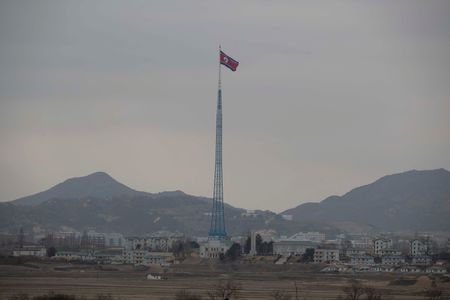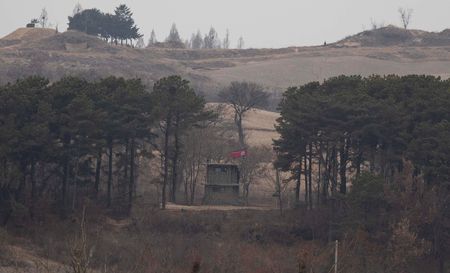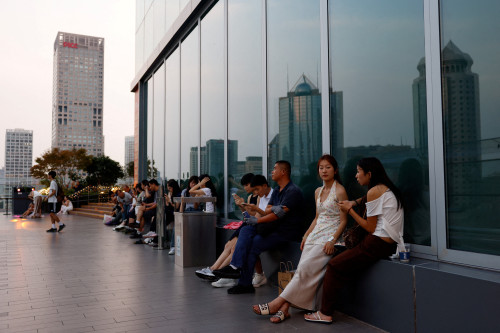SEOUL (Reuters) – A U.S. national was probably detained after crossing into North Korea on Tuesday during a tour in the “peace village” of Panmunjom, with its cluster of distinctive bright blue buildings and history of defections, tension and murder.
Known formally as the Joint Security Area (JSA), in the heavily fortified Demilitarized Zone (DMZ), it has been the centre of dramatic diplomatic and military incidents over the years.
Most infamously, axe-wielding North Korean soldiers in the DMZ in 1976 murdered two U.S. soldiers who were cutting down a poplar tree to secure a clear view. In 2017, a North Korean soldier was riddled with bullets by his comrades but ultimately survived as he made dash into the South.
Following are some facts about the 250 km-long DMZ, which separates North and South Korea.
– The DMZ marks where the 1950-53 Korean War – when China and North Korea battled U.N. forces led by the United States – ended with an armistice, not a treaty.
– The DMZ is a 2 km-wide buffer, stretching coast to coast across the peninsula, lined on both sides with razor wire, heavy armaments and tank traps.
– It is 60 km (37 miles) from Seoul and 210 km (130 miles) from the North Korean capital of Pyongyang.
– Inside the DMZ is the Joint Security Area (JSA). The so-called peace village of Panmunjom, where the armistice was signed in 1953, is located in the 800-metre-wide and 400-metre-long JSA zone.
– A Military Demarcation Line (MDL) marks the boundary between the two Koreas.
– Panmunjom is a cluster of distinctive bright blue buildings. The two Koreas have their own liaison offices and conference halls there, on each side of the MDL.
– At least six U.S. soldiers are known to have defected to the North after the war, mostly in the 1950s and 1960s. The last one was in 1982. Five of the six crossed into North Korea through the DMZ.
– Under a 1953 deal, the U.N. Command and the North Korean military were allowed to dispatch no more than 35 troops to the JSA, and each of them can only possess one pistol or non-automatic rifle. But the number of soldiers and weapons increased as relations worsened.
– The troops face each other across the MDL in Panmunjom. Communication is often difficult despite the close conditions. During periods of high tensions phone hotlines often go unanswered, forcing U.S. or South Korean officials to try to shout across the border.
– After a summit between the two Koreas in 2018, the two sides withdrew firearms from the JSA and reduced the number of troops to the original 35.
– Vast stretches of the DMZ have been no man’s land for more than 60 years, where wildlife has flourished undisturbed. Other parts of it offer an unsettling mix of military installations and tourist attractions.
– South Korea estimates the North operates about 160 guard posts along the DMZ and the South has 60.
– The DMZ is also littered with landmines planted over the decades – as many as 970,000 in the southern part alone, according to Landmine and Cluster Munition Monitor, a Geneva-based civic group.
– For years, both sides blared propaganda broadcasts over the DMZ into each other’s territory. The broadcasts ended after a 2018 military agreement.
(Reporting by Josh Smith; Editing by Tomasz Janowski)






